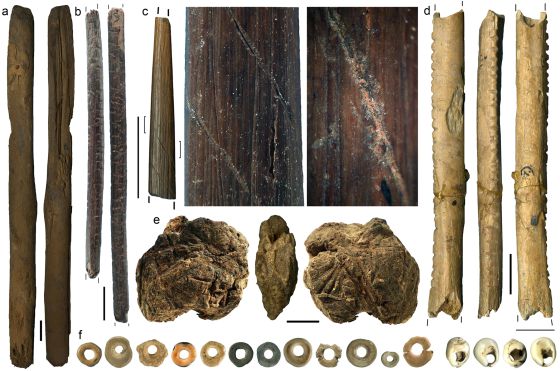Los San lo iniciaron todo
Hallados en Sudáfrica los primeros artefactos de la cultura humana moderna
Los bosquimanos propagaron hace 44.000 años la tecnología del cazador

El hallazgo incluye bastones de madera, punzones de hueso y ornamentos corporales. / f. d'errico / l. backwell
Una de las grandes paradojas de la paleontología es el llamado Gran Salto, o aparición repentina en Europa, hace unos 40.000 años, de los instrumentos avanzados propios de la creatividad humana moderna. Pero los últimos datos revelan que ese Gran Salto ya había ocurrido en África 4.000 años antes. Un grupo de arqueólogos encabezados por Francesco d’Erico, de la Universidad de Burdeos, acaba de descubrir estas evidencias en la cueva de la Frontera (Border Cave), un yacimiento de extraordinaria riqueza situado en el límite entre Suazilandia y la provincia surafricana de Zululandia, en el sudeste del continente. Los artefactos pertenecen a la cultura San, uno de los grupos de bosquimanos que, según todas las evidencias, inventaron la moderna cultura de los cazadores-recolectores que enseguida se propagó por el mundo.
Las huellas arqueológicas de instrumentos sofisticados y de la primera cultura simbólica de que se tiene noticia ya habían aparecido en este y otros yacimientos sudafricanos —en particular la cueva Blombos, en el puro extremo meridional del continente— en estratos datados hace 75.000 años. Sin embargo, esa cultura relativamente avanzada no debió establecerse con firmeza, pues desapareció 15.000 años después sin dejar rastro aparente.
Los artefactos de la cultura San hallados en la cueva de la Frontera, por el contrario, abarcan un periodo extenso de tiempo y un abanico mucho más amplio de tecnologías. Incluyen ornamentos corporales hechos de conchas y cuentas, huesos con muescas, bastones de madera para excavar, punzones de hueso y puntas de flecha del mismo material. Los resultados se presentan este martes en PNAS.
Los San también fueron los primeros, si no en domesticar a las abejas, al menos sí en utilizar la cera de las colmenas para sus propósitos industriales, según proponen los autores. La cueva de la Frontera contiene restos analizables de una pócima hecha con huevo, cera de abeja y resina de euphorbia, un material francamente pegajoso que los primitivos bosquimanos, posiblemente, utilizaban para adherir las herramientas a su mango. El primer pegamento de la historia, datado en 40.000 años.
El artefacto más reciente, que data de hace 24.000 años, es un aplicador de veneno que aún conserva restos tóxicos derivados de semillas de ricino. Nuestros ancestros no se andaban con tonterías a la hora de cazar.
Los resultados añaden fuerza a otras evidencias genómicas obtenidas el año pasado, y a los análisis lingüísticos que se han ido acumulando en los últimos años. También según estas líneas de investigación, nuestros primeros ancestros eran bosquimanos del sur de África, como los San, y se comunicaban en khoisán, el lenguaje-clic que probablemente fue lengua ancestral de la humanidad, donde las consonantes eran chasquidos como el que aún usamos para indicar fastidio, y como el sonido de un beso.
Los San y otros bosquimanos del sur revelan una variedad genética interna mucho mayor que cualquier otra población humana actual. Y la explicación más simple es que toda la humanidad actual proviene de aquellos primitivos habitantes del sur de África —no de Etiopía, como se pensaba anteriormente—, y que los actuales hablantes de lenguajes clic son los herederos en línea directa de nuestros primeros padres.
Las huellas arqueológicas de instrumentos sofisticados y de la primera cultura simbólica de que se tiene noticia ya habían aparecido en este y otros yacimientos sudafricanos —en particular la cueva Blombos, en el puro extremo meridional del continente— en estratos datados hace 75.000 años. Sin embargo, esa cultura relativamente avanzada no debió establecerse con firmeza, pues desapareció 15.000 años después sin dejar rastro aparente.
Los artefactos de la cultura San hallados en la cueva de la Frontera, por el contrario, abarcan un periodo extenso de tiempo y un abanico mucho más amplio de tecnologías. Incluyen ornamentos corporales hechos de conchas y cuentas, huesos con muescas, bastones de madera para excavar, punzones de hueso y puntas de flecha del mismo material. Los resultados se presentan este martes en PNAS.
Los San también fueron los primeros, si no en domesticar a las abejas, al menos sí en utilizar la cera de las colmenas para sus propósitos industriales, según proponen los autores. La cueva de la Frontera contiene restos analizables de una pócima hecha con huevo, cera de abeja y resina de euphorbia, un material francamente pegajoso que los primitivos bosquimanos, posiblemente, utilizaban para adherir las herramientas a su mango. El primer pegamento de la historia, datado en 40.000 años.
El artefacto más reciente, que data de hace 24.000 años, es un aplicador de veneno que aún conserva restos tóxicos derivados de semillas de ricino. Nuestros ancestros no se andaban con tonterías a la hora de cazar.
Los resultados añaden fuerza a otras evidencias genómicas obtenidas el año pasado, y a los análisis lingüísticos que se han ido acumulando en los últimos años. También según estas líneas de investigación, nuestros primeros ancestros eran bosquimanos del sur de África, como los San, y se comunicaban en khoisán, el lenguaje-clic que probablemente fue lengua ancestral de la humanidad, donde las consonantes eran chasquidos como el que aún usamos para indicar fastidio, y como el sonido de un beso.
Los San y otros bosquimanos del sur revelan una variedad genética interna mucho mayor que cualquier otra población humana actual. Y la explicación más simple es que toda la humanidad actual proviene de aquellos primitivos habitantes del sur de África —no de Etiopía, como se pensaba anteriormente—, y que los actuales hablantes de lenguajes clic son los herederos en línea directa de nuestros primeros padres.
















